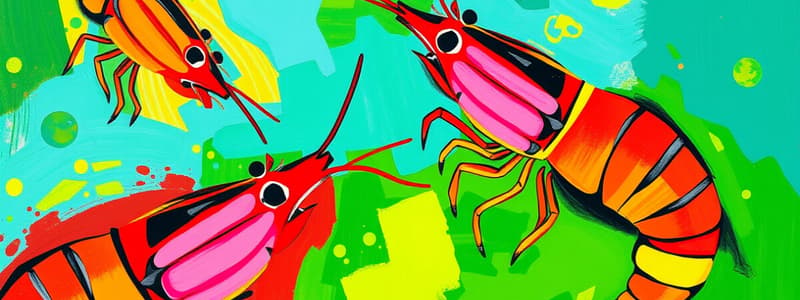Podcast
Questions and Answers
What is the maximum length of a male tiger prawn (Penaeus monodon)?
What is the maximum length of a male tiger prawn (Penaeus monodon)?
- 35.0 cm
- 250 g
- 4.22 cm
- 33.6 cm (correct)
What is the maximum weight of a tiger prawn (Penaeus monodon)?
What is the maximum weight of a tiger prawn (Penaeus monodon)?
- 4.22 cm
- 33.6 cm
- 35.0 cm
- 250 g (correct)
Tiger prawns (Penaeus monodon) are primarily scavengers.
Tiger prawns (Penaeus monodon) are primarily scavengers.
False (B)
At what age do tiger prawns reach full maturity and spawning in the wild?
At what age do tiger prawns reach full maturity and spawning in the wild?
What cleaning solution is recommended for disinfecting in a shrimp hatchery?
What cleaning solution is recommended for disinfecting in a shrimp hatchery?
Shrimp should be acclimatized by placing them in white basins with __________.
Shrimp should be acclimatized by placing them in white basins with __________.
What is the recommended feeding density for diatoms (Skeletonema sp.)?
What is the recommended feeding density for diatoms (Skeletonema sp.)?
What type of fertilization is used for indoor culture of diatoms?
What type of fertilization is used for indoor culture of diatoms?
Eyestalk ablation is necessary for male tiger prawns to attain maturity.
Eyestalk ablation is necessary for male tiger prawns to attain maturity.
What should be done with the spent spawners after checking if they have spawned?
What should be done with the spent spawners after checking if they have spawned?
The water change starts at __________ at PL 1 and gradually increases.
The water change starts at __________ at PL 1 and gradually increases.
Study Notes
Tiger Prawn (Penaeus monodon) Overview
- Habitat includes estuarine environments, mangrove inlets, and shallow brackish waters.
- Juvenile tiger prawns thrive in tropical temperatures typically between 17-38°C.
- Maximum lengths are 33.6 cm for males and 35.0 cm for females, with a weight capacity of 250 g.
- Feeding primarily involves predation on benthic macro-invertebrates like small crabs, mollusks, and some fish.
Reproductive Biology
- Tiger prawns are gonochoric, reaching full maturity in about 10 months.
- Spawning occurs in two peak seasons: December-March and June-September.
Biosecurity Standards in Prawn Hatchery
- Implementing strict biosecurity measures is essential to prevent disease outbreaks among shrimp stocks.
- Standard Operating Procedures (SOP) include:
- Establishment of a separate spawner/broodstock facility for pathogen detection and quarantine.
- Use of 200 ppm chlorine solution for thorough disinfection of facilities and equipment.
- Installation of individual aeration lines and separate materials for each tank to avoid cross-contamination.
- Only authorized personnel allowed in hatchery; use of gloves recommended to prevent contamination.
Natural Food Production Techniques
- Diatom Culture (Skeletonema sp.):
- Indoor culture requires UV-sterilized seawater and a mix of fertilizers for optimal growth.
- Outdoor culture uses fertilizers such as urea and ammonium phosphate, expecting a bloom within 3-4 days.
- Brine Shrimp (Artemia) Culture:
- Cysts are hydrated, disinfected, and incubated in UV-sterilized seawater for 24 hours before harvesting.
Prawn Hatchery Operations
- Selection and Processing of Spawners:
- Spawners require acclimatization and disinfection with 50 ppm povidone-iodine.
- Gonadal maturity checked via lighting during transfer to spawning tanks.
- Eyestalk ablation necessary for female prawns to trigger maturity; performed on healthy, hard-shelled individuals.
Eyestalk Ablation Process
- Surgery method options include pinching, ligation, cautery, and cutting, with preference for the pinching method due to less stress and faster healing.
- Post-ablation, prawns may spawn within three days, with a maximum mortality rate acceptable at 10%.
Egg Disinfection and Treatment
- Post-spawning, eggs are harvested and subjected to a disinfection process using povidone-iodine.
- Rinsing and stocking in clean, aerated tanks enhance hatching.
Nauplii Harvesting and Stocking
- Nauplii should be processed from PCR-negative spawners to avoid pathogen transmission.
- Habitat acclimatization occurs before transferring them to hatchery tanks.
Water Management and Quality Monitoring
- Regular water changes initiated post-metamorphosis, starting at 10% for PL 1 and increasing up to 50% as growth progresses.
- Daily health monitoring and bacterial analyses conducted to detect diseases.
Harvesting of Postlarvae
- Harvesting procedures minimize stress on postlarvae; involves controlled water reduction and collection in prepared harvesting nets.
- Postlarvae are concentrated and transferred to UV-sterilized seawater for packing and distribution.
Packing and Transport of Shrimp Fry
- Harvested fry placed in aerated basins; density evaluated for transport needs.
- Double polyethylene bags used for transport to maintain oxygen levels and manage water temperature, especially for long journeys.
Studying That Suits You
Use AI to generate personalized quizzes and flashcards to suit your learning preferences.
Related Documents
Description
Prepare for the 2024 Fisheries Professional Licensure Examination with a comprehensive review focused on tiger prawn hatchery operations. This class, led by expert aquaculturist Christian N. Garcia, will delve into the essential biology and practical aspects of aquaculture. Join us to enhance your knowledge and skills for the upcoming exam.




